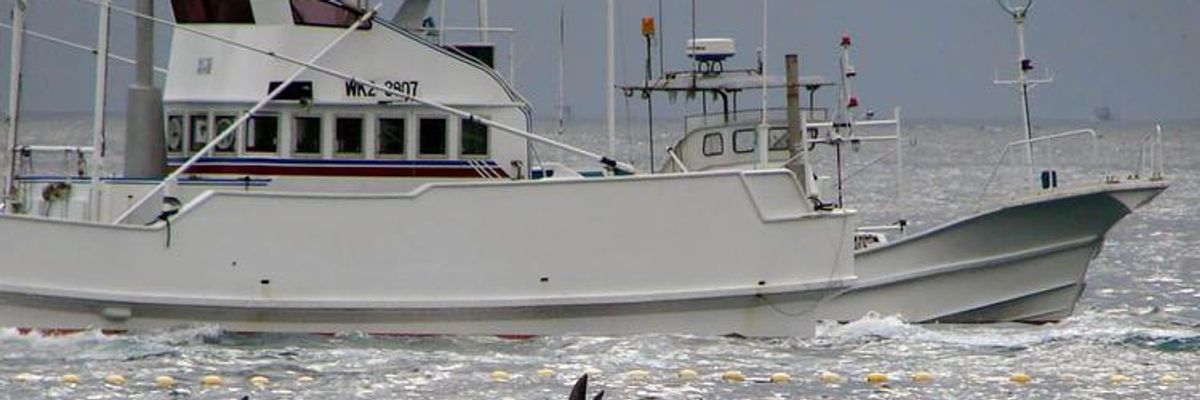The notorious annual dolphin hunt got underway last week in the small Japanese town of Taiji. During the six-month hunting season, terrified dolphins are violently herded into a narrow cove. Most are slaughtered -- but scores of "good-looking" ones are captured and shipped off to aquariums.
The Taiji hunts always receive a barrage of condemnation, and especially so since the release of the Oscar-nominated documentary "The Cove" in 2009. While the hunters maintain they are culling dolphin "pests" who eat too many fish, the primary economic incentive for the Taiji drive hunts is the aquarium industry. Live dolphins sell for around $50,000, and this is what keeps the hunters in business.
If there were no demand for live dolphins from Taiji, it is highly likely this annual slaughter of hundreds of dolphins would cease.
After legal action last year from the advocacy group Australia for Dolphins and significant public pressure, the World Assn. of Zoos and Aquariums changed its policy and began to oppose the capture of cetaceans. To maintain membership in WAZA, all member aquariums had to agree not to buy dolphins from Taiji or any other drive hunt.
Strangely, the professional association that represents dolphin trainers hasn't taken the same step. The International Marine Animal Trainers' Assn. strongly opposes the dolphin slaughter that occurs in Taiji, but it accepts the capture of dolphins that happens during the same hunts. IMATA has a policy that expressly allows its members to participate in the brutal collection process in Taiji, during which dolphins are dragged through the water by their tail flukes and violently torn from their families. According to the organization's statement, a trainer is welcome in IMATA "even if s/he participates in the selection and collection of live animals on the premise that those animals will benefit as s/he is exposed to the most current best practices in animal care and training."
To those who have been to Taiji and witnessed a drive hunt, it is obvious that the killing and capture of dolphins are inextricably linked. Because the capture fuels the slaughter, IMATA cannot rationally condemn one while accepting the other. Dolphin trainers in wetsuits and hats brandishing the IMATA logo stand side by side with the Japanese hunters, choosing which dolphins will live in their aquariums and which will die.
Dolphins weigh up to 1,100 pounds, so it is not a gentle process to haul them into a boat. They struggle, often injuring themselves. Some even purposely beach themselves on rocks in an attempt to save themselves. The initial herding process, where dolphins are chased by speedboats and driven to the point of exhaustion, is also incredibly cruel, leading many dolphins to drown or die from cardiac arrest. From an animal welfare perspective, these hunts are truly shocking. From a conservation angle, the hunts are devastating for local dolphin populations, which are at risk of extinction. Last year, more than 650 cetaceans were killed, and 117 captured.
If IMATA were to change its policy, marine facilities around the world would find it difficult to source wild dolphins. It would give trainers, too, second thoughts about participating in a process that is condemned by the entire zoo and aquarium community, facilities and training associations alike.
SeaWorld could also lead the way. The theme park chain has been bending over backward to improve its image since the release of the 2013 documentary "Blackfish." Still, many SeaWorld trainers are IMATA members, including the organization's first vice president, and the company is also hosting IMATA's annual conference in November in San Diego.
Last year, the company committed to never buy cetaceans taken from the wild again. To make that commitment stick, it should cut all ties to the Taiji hunts -- including to organizations such as IMATA that allow members to be directly involved in the dolphin hunts.
If the history of the animal rights movement has taught us anything, it is that big wins for animals do not come about as quickly as we might hope. Still, important progress has been made in many areas of animal welfare, including within the entertainment industry. It once seemed radical to oppose many animal abuses -- for example, keeping laying hens in battery cages. Now the idea is so mainstream that even McDonald's and Walmart have agreed to phase out the use of eggs from caged hens.
Rightly or wrongly, most Americans care more about dolphins than hens. Hopefully, IMATA and SeaWorld will soon realize that their publicly stated concern for dolphins' welfare must extend beyond their pools and tanks to include the wild, free-living dolphins off the coast of Japan.

